In theory, your oil filter has a simple job: capture wear-causing contaminants and hold them in the filter media so they don’t run amok inside your engine.
But lots of factors can throw a wrench into this plan, which can raise filtration questions.
Here’s what we’ll cover:
Can I use the same filter twice?
The filter is designed to capture contaminants and hold them within the filter media. Over time, the media fills with dirt particles, agglomerated soot, metal particles and other junk. If the filter plugs, the pressure differential will open the bypass valve, which allows oil to bypass the filter, preventing oil starvation. Sure, dirty oil is preferable to no oil, but it’s not a long-term plan you can trust.
A new filter is far less expensive than a new engine. Don’t cheap-out – replace the filter with every oil change.
How long do filters last?
It depends on filter quality and your driving conditions.
A low-quality, cheap conventional filter doesn’t offer the capacity of a filter using synthetic media, meaning it fills with contaminants faster and requires more frequent changes.
Plus, if you drive in dusty, dirty conditions, your engine is exposed to increased levels of airborne dirt particles that can enter the engine, especially if you haven’t changed the air filter in awhile or there’s a leak in the intake system.
Some modern direct-fuel-injection vehicles experience elevated fuel dilution, which also takes a toll on the filtration system. In diesel engines, soot particles can agglomerate into larger contaminants and lodge in the filter. This all adds up to more contaminants and more stress on the filter.
Follow the filter manufacturer’s service guidelines. If none are given, go with what’s recommended in your vehicle owner’s manual.
I forgot to change my filter when I changed oil. Is it too late?
No. Just change the filter as normal.
After the new filter is installed, run the engine for a couple minutes, then shut it off and allow several minutes for the oil to settle in the sump. Check the oil level and top-off as needed to make-up for the oil removed with the old filter.
Should I pre-fill the filter before installing?
The Internet is full of pre-fillers and anti-pre-fillers, all of whom seem able to reference a high-mileage conversion van or pickup they’ve serviced for decades either pre-filling or never pre-filling the filter.
Some filter manufacturers say pre-filling the filter isn’t necessary. But remember – they make filters, not engines. There’s a reason engine manufacturers recommend 0W-XX or 5W-XX motor oils, and it’s so the oil flows readily at startup when it’s cold and the engine doesn’t go without vital lubrication while it builds oil pressure.
To help ensure the engine doesn’t start dry, we recommend you pre-fill the filter if you can.
Horizontally oriented filters can pose a problem, but even they can be pre-filled with some oil.
I typically pour a little oil into the filter and tip it sideways and check the oil inside. If there’s room for more before it begins to spill out of the opening in the filter, I add a little more oil before installing the filter.
Should I use a conventional or synthetic filter?
Use a filter made with synthetic media for best protection. Synthetic oil filters offer the following benefits:
- Increased efficiency – Efficiency describes the filter’s ability to capture contaminants. You can usually find a filter’s efficiency rating on the package or the manufacturer’s website. It’s reported as a percentage followed by a micron rating (e.g. “99 percent at 20 microns,” which is the efficiency of AMSOIL Oil Filters). It refers to the percentage of contaminants 20 microns and larger the filter traps in industry-standard (ASTM D4548-12) testing. The higher the percentage, the better.
- Increased capacity – Capacity refers to the amount of contaminants a filter can hold while still remaining effective. While there’s no industry-standard capacity rating, similar to the efficiency rating noted above, full synthetic media offers greater capacity than conventional media. The smaller fibers in synthetic media allow more room for contaminants to lodge without restricting oil flow.
- Improved durability – Hot oil slowly degrades the resins that hold some filter media together. Extreme temperatures also degrade the anti-drain valve and baseplate gasket. Use a filter with reinforcement on the media, such as a wire backing, to withstand increased heat and longer drain intervals. Look for an anti-drain valve made of silicone for maximum durability. This ensures the oil stays in the filter after the engine is shut off, preventing dry starts the next day.
What’s inside an oil filter?
Most spin-on filters contain the following:
- Filter media – the heart and soul of the filter. It’s where contaminants go to die. Once they lodge inside the filter media, they can’t circulate throughout your engine and cause wear.
- Anti-drain valve – prevents oil from draining out of the filter when you shut-off the engine, ensuring immediate oil pressure at startup.
- Gasket – technically it’s on the outside of the filter, but the gasket that creates a seal against the engine block is critical to preventing oil leaks.
Can I use synthetic oil with a conventional filter? Or vice versa?
Yes, it’s perfectly safe to use either type of filter with either type of oil.
If you practice extended drain intervals using synthetic oil, however, a conventional oil filter may not offer the required service life, meaning you’ll have to change it in the middle of the oil drain interval, which is inconvenient.
That’s why AMSOIL Oil Filters are constructed to last up to 25,000 miles between changes, coinciding with the 25,000-mile drain interval of Signature Series Synthetic Motor Oil. AMSOIL Oil Filters designated with product code EA15K offer 15,000-mile change intervals.
Updated: Originally published Oct. 16, 2017

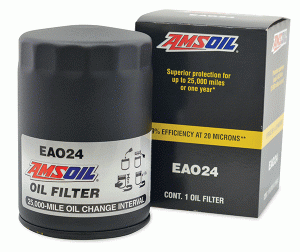
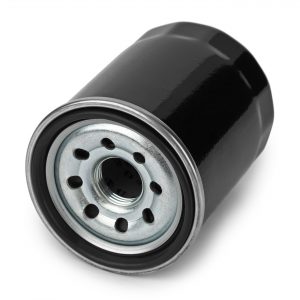
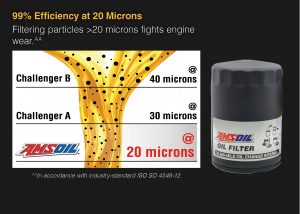
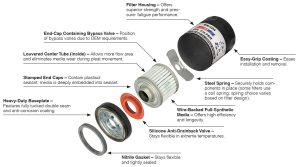
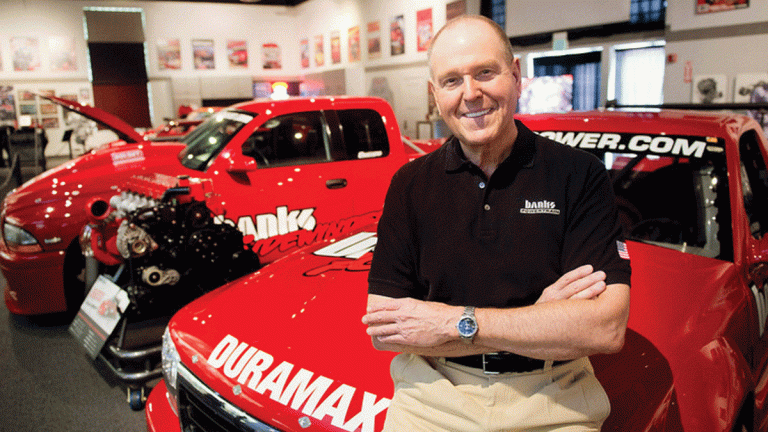



People like what they like, I make a project out of an oil change….try this on your next one…I cut off the spout part of one of the bottles and use the bottom 3/4 of the container to drain the oil out of the other bottlles…I get almost two shot glasses worth of oil after letting the empty bottles hang up side down in the bottle I cut the spout off from. I usually let them drip there for a day….This oil is sticky and it sticks to the inside of the bottle very well….I know every so often the industry say”we recommend” this now but tried and true always works…I picked up a few filters this weekend and the lack of types of brands to choose from is getting slimmer….I stay with OEM but l noticed that the extended range filters are in the $12 dollar range….I guess if you hate changing oil then that would be a better price option but if you are a 2 times a year and under 12.000 miles like me then I’ll have to get what I can when I can…The shelves I seen this weekend were either one sided with one of off name brands or high prices big namers….Oil needs to be changed and you need to be on top of your driving habits to balance the costs….less is best but no one answer covers everyone…
Only time an engine starts dry is after a rebuild. Bearings lubed with white whipped oil from a tube. If you think an engine goes dry during an oil change let it,sit as long as you like. Remove the pan and change a couple bearings. I’m a 40 year mechanic and have tried letting it drip dry. Can’t be done. Doesn’t take long at all for oil pressure to fill the filter plus many vehicles have a filter mounted sideways. In my opinion pre filling an oil filter is just another one of those things because people have done it that way for years.
Mobil one offers 20000 mile filters for my vehicle to go with their annual
Protection product you only off the 15K filter for my 2015 Nissan Versa note. Are you going to offer a longer lasting inh filter?
Hi James,
We offer an AMSOIL Ea15K Oil Filter for your Nissan Versa, which provides a 15,000-mile service interval.
If you elect to use the Mobil 1 Extended Performance filter for its recommended 20,000-mile service interval, just make sure you understand the fine print regarding Mobil’s filter warranty:
Pay special attention to line “d” above. Also, check out Mobil’s FAQ page, where they tell you to “Please follow the recommendations in your owner’s manual while your car is under warranty.”
Your Nissan Versa Note carries a 5,000-mile/six month oil-change recommendation. So, if you follow the recommendation in your owner’s manual, as Mobil instructs, your 20,000-mile oil filter essentially becomes a 5,000-mile oil filter.
In contrast, if you use an AMSOIL Ea15K Oil Filter in your Nissan, the AMSOIL Limited Warranty will cover you in the unlikely event of a filter-related problem regardless of the oil-change recommendation given in your owner’s manual. That means you can confidently use the filter for its full 15,000-mile service interval and sleep well at night.
Plus, AMSOIL Ea15K Oil Filters provide better efficiency (98.7% at 20 microns, compared to 99% at 30 microns for the Mobil 1 Extended Performance filter).
Thanks for reading.
But if you pre-fill should you pre-fill from the filter’s large centre hole or from one of the perimeter inlet holes so you can be sure all the oil that goes in is filtered and no contaminates enter the system? There are those strongly recommending the latter see http://beamalarm.com/Documents/prefilling_oil_filter_instructions.html and http://www.widman.biz/uploads/Corvair_oil.pdf (point 23 page 20) and https://www.youtube.com/watch?v=P6MLDH0zTp And whatever side your pre-fill on does it move to the other side or is the visible drop in oil level inside the filter simply the media soaking it up? Is new oil contaminate free?
Hi Ross,
Fill the filter whichever way is easiest for you. New oil from the original package should not be contaminated, so pouring it into the center hole of the filter is OK. As you pour oil into the center hole, you will fill the volume and the media will begin soaking it up until saturation. Oil will naturally flow through the media, helping fill the entire canister. Many filters have anti-drainback valves, making it hard to fill the filter without using the center hole.
If you have concerns about this, use an oil you can trust to be manufactured properly. I can’t speak for the other oil companies, but we take pride in the manufacturing of our products, and each and every gallon we produce is filtered prior to going into the bottle, providing you exceptional engine protection.
Thanks for reading.
Can another grade of Oil be used other than the recommended one for your Engine? Ie 10W30 instead of 5W20?
Hi Dave,
Great question. In fact, we wrote a whole blog post about it. Check it out here.
Thanks.
You can go 20K miles if you use the best oil filter money can buy- FRAM Ultra Synthetic. The ONLY filter that has the capacity to go 20k with no time restrictions. 99.9% efficiency@20 microns and 8.99 at retail. There is nothing better.
Have you ever opened a fram filter and actually seen the inferior parts and design that it’s made with??
Yes I used to use Fram oil filters, some years back, but after seeing some of the YouTube video’s on oil filters, I’ll stick with AMSOIL filter, yes they are more money but I think they are worth it!
Never go 20,000 miles on an oil change, ever, no matter what any one ever tells you!
Wiilie Jenkins: You do realize you’re on an AMSOIL site? AMSOIL has oil that is warrantied for 25,000 miles.
I can confidently presume that the writer of this post hasn’t done many overhauls or teardowns. Dry starts are not really a normal thing. Most engines build oil pressure in the first 2-3 seconds of cranking. Also if you teardown an engine and leave it on the stand, it will literally drip oil onto the floor for months. I’ve rebuilt 6-12 stationary power unit engines for irrigation every year for the last 15 years, and seen tons of things happen to them, but dry-start damage isn’t one. Most of these see more oil changes each year than the average car in 5 years, 24hrs/day 5 days a week with oil changes every 100-200 hrs. They average 2200 rpm on gas motors, and 1500 rpm on diesels for 4-5 months per year. The gas motors are usually due for a valve job at 8-12 yrs, and a complete overhaul by 20 years depending on how hard they work and maintenance plans.
I have a 67 E jag that uses fabric type filters . Have used them in Jags since 1961 without a oil problem. Of course no extended oil changes. I am wondering If these particular filters are better than most natural fiber ones. Also does Amsoil offer a recommendation as to oil for XKE 4.2 1967. As well as trans and differential oil.
Hi Keith,
Contact AMSOIL Technical Services (715-399-TECH; [email protected]) for recommendations for your Jaguar.
Thanks,
John
I’ve been changing oil since I was around 13, had to change my Dad’s oil when I was a kid. I’ve never filled the oil filter with oil before putting it on. I’m 58 now. Actually never heard of it till recently, I don’t think it is a bad idea, but I agree with Scott above theirs enough residue in the motor to protect it for a few seconds which is all it would take to be protected before circulating again at full capacity. Having said that maybe I’ll start putting a little in the filter!
The article is great, I found many useful things.
Ok here is one for you Subaru owners…… like me
I have a 2017 Subaru Outback
The oil filter sits at the top of the motor and it’s upside down
As in the opening faces down as you install it.
Not possible to pre fill this setup
Also I noticed that every morning the car is started it rattles for a few seconds like there is no oil in the motor.
This got me thinking. Is this filter emptying out over night and causing a dry start very morning?
So I decided to remove the filter and see if there was anything in it before starting the car in the morning….
What did I find? Not a drop of oil was in the filter. It all drains back overnight.
I decided to go to the Subaru forums and low and behold most people have herd the startup rattling.
Subaru what were you thinking ??????
Yes good filters like Amsoil have drain back valves. But oil can still drain back from the return hole. (The center off the filter)
Especially on a filter that is installed upside down!!!!!!
Rob
Due to the horizontally apposed format, subys also suffer from ring land failure. On startup after a long sit, the ground facing portion of the piston ring may be lubricated, but the sky facing portion will be bone dry……. sometimes, the unlubricated ring will stick and kapoweee, it will destroy the grove (ring land) in the piston that it rides in. Usually takes out a lot more on the way. This self distruct mode usually activates EARLY in life, and results in often waranteed engine replacement. On the other hand, many subies, with the upside down filter, run into the 300,000 range, and keep going long after they leak sludge out of every orafice. “Tech:It says in the system that cv boot has been broken since 2009, whats left of the grease is fosilized in the wheel well”
“Owner:So obviously its fine then!!” As a long time tech, they are in fact reliable, and well made cars, with insane engineering that somehow mostly works, so honestly, as sketchy as it may seem, if it does not cause any trouble, don’t let the morning pea thresher bother you! If yours runs right, has good oil and filter, don’t leak oil out, has good pressure, is otherwise up to date on service, and the noise is nothing new, relay and enjoy.
Can I use the same filter twice?
Who in their right mind would ever change the oil without also changing the oil filter? Wow…just WOW! Whomever asked that question needs to stick to leaving their auto maintenance to a professional.
AMSOIL
Pls make a filter for my GM 2.8 diesel.
The cardboard filter from GM looks extremely cheap.
I don’t want paper or GMs cardboard filter I want synthetic fiber filter.
Rob
Hi Rob,
We are adding the WIX WL10286 as a first option. It should be available in the next few weeks. We’ll monitor sales of the WIX filter and, if sales justify it, we’ll introduce an AMSOIL filter for that application.
Thanks,
John
What about just changing the oil filter and topping off the oil like they do on locomotives? They run 24 hours a day and very seldom shutdown using the same oil for two years and millions of miles.
They also have pistons so big they make excellent outdoor ash trays. Very different operating conditions and tolerances. In your vehicles internal combustion engine, if oil is dark/black, Its time to get it out. This goes for long change synthetics too. Super oil wont break down over a long run, but if/when it is contaminated with carbon/crud, its time to change, no matter what the mileage. I also caution certain customers about long duration changes IF there car does not come in with good oil level. Some consumption is normal on many cars, but if the ride is going to be out of oil at 7500 miles due to seepage, then no product can protect it to 10000……
My 2018 Harley 1200 Custom Service Manual states to put 4 ounces oil in the filter. And 2 quarts in the tank. Start and check. I do the same with all my vehicles with screw on filters. In 30 years of driving, never had engine problems. As a mechanic, some engines started noisy after an oil change. Why I put some oil in the filter when possible.
I enjoyed reading this article, but couldn’t find the answer to its title “can the oil filter be used twice”?
I always use 0w20 synthetic oil for my Toyota Highlander with new FRAM filter changed; however, this time mechanic claimed that he is not able to open the filter holder to change it. He asked to leave it for next time change. I had no choice than to accept the idea and seek Toyota dealership next time.
The question is can the oil filer whether Farm or original Toyota product be used of up to 16k rather than 8k km?
Hi Ibrahim,
As noted in the post, “A new filter is far less expensive than a new engine. Don’t cheap-out – replace the filter with every oil change.”
It’s best to always change the oil filter when you change oil. Did you ask the mechanic why he couldn’t open the filter holder? Was there a problem with it? That’s a strange thing to hear from your mechanic. If it were me, I’d find a new mechanic.
How long you can use your oil filter safely depends on several factors, such as operating conditions, filter quality and manufacturer’s recommendation. I recommend following the service interval provided by the filter manufacturer. If you’ve surpassed it, have the filter changed as soon as possible.
Thanks,
John